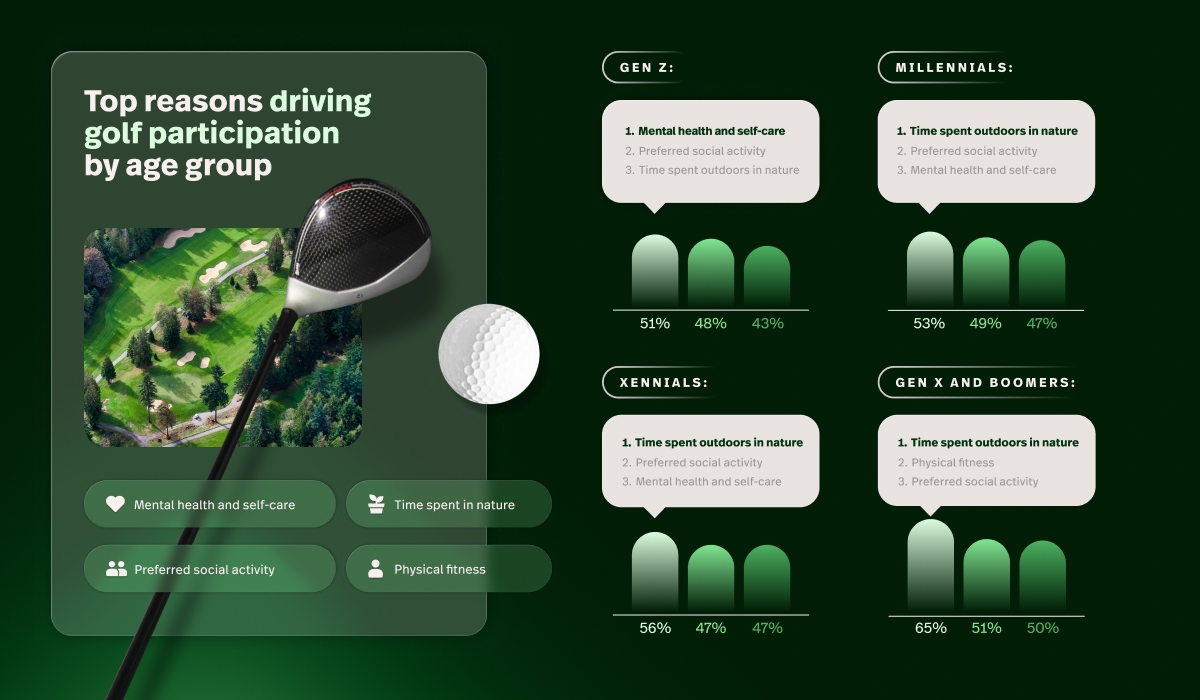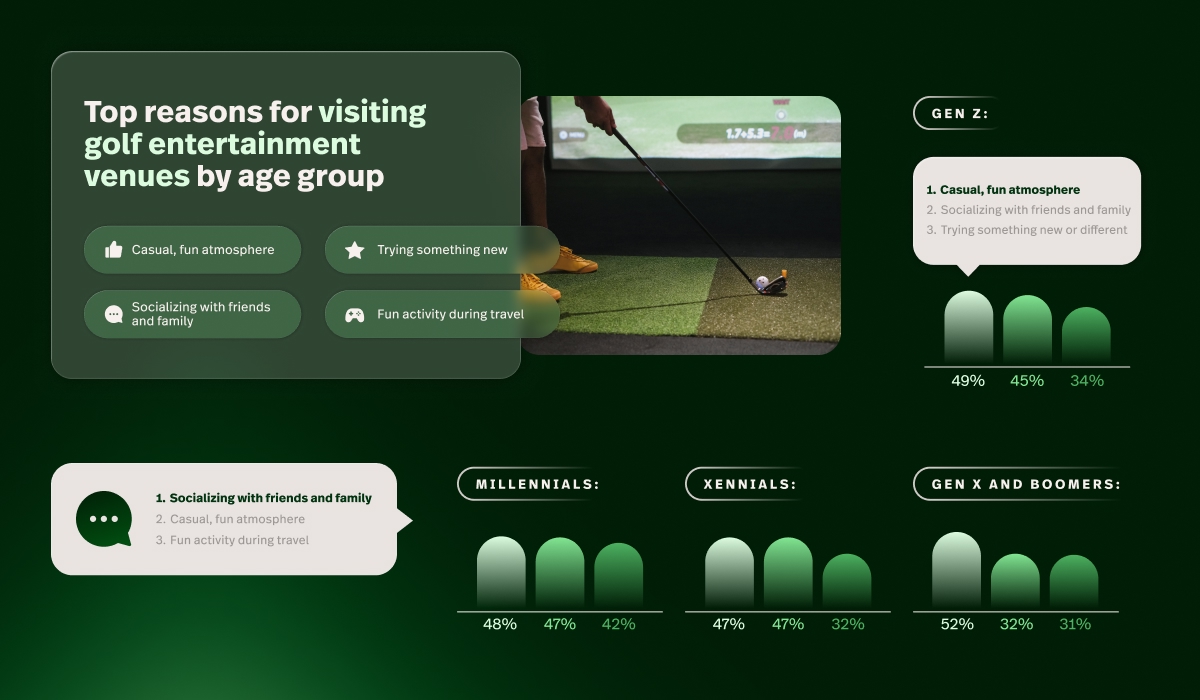
With 2024 in the books, recreational golf remains on the upswing.
While the unprecedented growth seen during the pandemic has slowed, golf industry trends indicate that the game is more popular than ever.
One contributor? The growing participation among 18–34-year-olds, which reached a near decade-high in 2023 and grew for the sixth straight year in 2024. With Gen Z and Millennials key to the industry’s future, it’s essential to understand how and why they engage with the game.
What draws them to golf? Where and with who are they playing? What are their spending habits? And how do their motivations differ from those of older generations?
We analyzed survey data from more than 700 North American golfers to uncover what drives recreational golf participation across different generations heading into a crucial 2025.
- Self-care on the course? Golfers are drawn to golf’s mental health benefits
- Golfing solo is gaining traction with younger golfers
- Gen Z and Millennials view memberships and passes as value drivers
- Golfers turn to tech for social, laid-back, unique golf experiences
2025 Golf Industry Trends Report
Want to learn more about the state of the industry in 2025? Download our free report now!
1. Self-care on the course? Golfers are drawn to golf’s mental health benefits
Golf is as much a mental game as it is a physical one—and that’s part of its appeal. Even during the worst rounds, players have time to disconnect, immerse themselves in the game, set goals and overcome challenges.
And if all else fails, it’s still a few hours spent outdoors, whether alone, with friends or with family.
As golf draws more Gen Z and younger Millennials, its appeal as a source of mental well-being, connection and refuge is clear.

- A majority of Gen Z (51%) ranked mental health and self-care as the top reason they play golf
- It was the third-most popular response (47%) among 25-34-year-old Millennials and Xennials (older Millennials on the cusp of Gen X)
- Overall, personal well-being emerged as a primary driver of participation across all age groups
With health and self-care fueling its popularity, golf has become more than a pastime. It’s a revitalizing outlet for younger adults seeking balance in their lives.
Key takeaways
Selling golfers on a lifestyle, a feeling or an emotion is a crucial part of any marketing strategy. Based on the insights above, how can you position your course as a positive outlet for mental health and personal well-being?
Private clubs often excel at this, and public and semi-private facilities should take notice. You can emphasize:
- Your course’s natural beauty and setting
- The sense of community you foster
- The positive emotions golfers associate with playing your course
- Unique events or experiences that differentiate your facility
- The quality of your amenities: practice areas, dining, etc.
By showcasing these elements, you can position your facility as more than just a place to play. It becomes a destination that resonates with golfers on a deeper, more personal level.
2. Golfing solo is gaining traction with younger golfers
Green grass golf is not just a group activity. Sometimes, it’s an ideal way to take time for yourself.
For Gen Z, Millennials and Xennials drawn to golf for personal well-being, playing solo or as a single is something they seek out regularly.

While a majority of golfers across all age groups said they would play a round of golf solo or as a single, the percentage was highest among younger Millennials (ages 25-34) at 84%.
Interest was lower among older generations, with 69% of 55-65+ golfers saying they would golf solo.
But how does this translate into actual playing habits?
How often would you play a round of golf by yourself?
According to our survey data, solo golf is mostly favoured by younger generations of golfers:
| Gen Z | Millennials | Gen X and Boomers | |
| Always or primarily | 29% | 21% | 14% |
| Whenever I can | 39% | 39% | 32% |
| Once in a while | 32% | 40% | 55% |
Notably, nearly a third (29%) of Gen Z golfers we surveyed said they always or primarily seek out solo/single tee times. Another 39% said they do so whenever possible—a figure matched among Millennials.
Gen X and Boomers were more ambivalent about playing solo, with most saying they wouldn’t mind doing it once in a while.

So, why are golfers going solo?
- A majority (51%) of Gen Z respondents said solo golf was ideal for self care and taking time for themselves
- Self-care was also the top response (39%) among all Millennial survey respondents
- Over a third of Millennials (36%) said booking solo made it easier to fit golf into their schedules
- Focused practice ranked among the top three benefits for golfers across all age groups
Key takeaways
Fully solo play isn’t something that any daily-fee course is going to actively advocate for — and understandably so. From an operational and revenue standpoint, sending a single out alone doesn’t make sense. But that’s not really the full story here.
What this trend also speaks to is that a growing number of golfers are willing to book a round on their own and fill in an empty slot on the tee sheet. Many “solo golfers” head to the course alone knowing they’ll be paired with others—and they’re fine with that. And that’s behavior worth paying attention to.
If your course has a fair policy toward booking as a single, you’re in a better position to turn a group of two or three into a group of four. Every empty slot on the tee sheet is a chance to generate revenue, and making it easy for golfers to book on their own helps fill those gaps.
So while solo play in the purest sense might not be ideal, the data points to something valuable: golfers want flexibility, and when given the right tools and a clear path to book, they can help maximize your tee sheet efficiency.
3. Gen Z and Millennials view memberships and passes as value drivers
Memberships are generally thought to be better suited to the lifestyle of older generations of golfers. But with daily fee golf growing more expensive, a majority of younger golfers see memberships and passes as ideal for their needs: they are cost-effective solutions that let them play more and maximize value as the cost of golf grows.
Golfers planning to purchase a membership or season pass at a course next season by age group:
| 18-24 | 25-34 | 35-44 | 45-54 | 55-64 | 65+ |
| 71% | 76% | 70% | 64% | 54% | 35% |
While 66% of all survey respondents indicated they would purchase a membership or season pass, Gen Z and Millennials were the most motivated. Nearly three quarters (74%) of 18-34 golfers said they plan on purchasing a membership or season pass at a facility next season.
Notably, this majority was consistent across household income brackets.
Percentage of Gen Z and Millennials planning to purchase a membership or season’s pass next season by household income:
| <$20K | $20-39K | $40-59K | $60-79K | $80-99K | $100-150K | $150-199K | >$200K |
| 66% | 80% | 71% | 75% | 68% | 84% | 71% | 100% |
When asked whether inflation is making them consider changing how they access golf, over a third (35%) of Gen Z and Millennials said they are considering switching from paying for single rounds to purchasing a membership, multi-round package or a season pass.
The primary reasons for this change are illuminating:

Key takeaways
These golf industry trends around Gen Z and Millennial buying habits show that value is at the forefront of their decision making. These demographics are serious about golf and can be willing to pay larger upfront fees to a single course if it means unlocking long-term value.
Golf operators and their teams cannot afford to overlook this data; it’s essential to evaluate loyalty programs and membership plans to ensure they provide the value and flexibility that golfers are looking for.
Survey your golfers: Gather direct insights from your customer base to understand their preferences for passes and memberships. Design your surveys thoughtfully, segmenting responses by age group, skill level, household income and other relevant factors for a more accurate picture.
Offer flexibility: From tiered subscription-style memberships and intermediate plans to flex-pay options and value packs, create a number of avenues that fit different lifestyles.
Spread the word: With the help of a strong CRM and marketing tools to collect and segment customer data, golf facilities can create targeted campaigns, analyze performance and make data-driven adjustments to maximize marketing impact.
4. Golfers turn to tech for social, laid-back, unique golf experiences
Off-course golf industry trends have become major talking points in recent years, thanks in part to the accessibility of golf simulators and ball-tracking technology.
- Entertainment venues like Topgolf and Drive Shack are everywhere
- Indoor simulators are used in homes and businesses
- Driving ranges are adding Trackman or GCQuad
- And a new golf simulator league featuring some of the world’s best players kicks off in 2025.
This technology has helped off-course golf attract a younger and more diverse audience than traditional green-grass golf.
But what is it about these off-course venues that drive such hype? And how does it differ from what they’re looking for from the golf course?
Self-care on the course, socializing off the course
We’ve seen how many Gen Z and Millennials often turn to green-grass golf for self-care or solo time. But when it’s time to socialize, entertainment venues like Topgolf are their go-to.
When asked how golf entertainment venues compare to traditional golf, 39% of Gen Z and Millennials said they prefer them for a casual, social experience.
In fact, this atmosphere appealed to all age groups, with 50% of all survey respondents citing socializing with friends and family as the main draw of these venues.

Golfers across all age groups clearly agree on key benefits of golf entertainment venues. In ditching tradition for tech, food, drink, music and good company, golf industry trends indicate that these facilities offer a completely unique, valuable golf experience.
But when it comes to actually visiting these venues, there’s no question that they appeal to a younger demographic of golf enthusiasts.
Golfers who visit golf entertainment venues by age group
| Gen Z | Millennials | Gen X and Boomers |
| 68% | 62% | 49% |
The appeal was so strong that a remarkable 50% of all Gen Z and Millennials said they would consider replacing traditional golf outings with more visits to entertainment venues.
Older generations were less definitive, with 34% of Gen X and Boomers saying they would consider replacing traditional golf outings.
With technology so central to the appeal of entertainment venues like Topgolf and Drive Shack, how did different age groups feel about the addition of other technologies into the golfing experience?
Key takeaways
Simulators and ball tracking technology are helping to fuel a new kind of golf experience that’s fun, laid back, social and agnostic of seasonality.
Rather than see these golf industry trends towards tech any sort of threat, golf course operators should embrace these changes. From simulator bays to an enhanced driving range experience, this technology presents facilities with the opportunity to scale their operations and add new services that all golfers will love.
Read our blog on creating a golf simulator business plan at your course
Here’s to keeping the momentum going in 2025
In light of these golf industry trends, the future is bright for customer-centric courses who are continuously leveling up their operations and finding ways to simplify, scale and provide exceptional experiences for golfers across all age groups.
At Lightspeed, we’re committed to serving ambitious golf courses who want to succeed and thrive—now and in the future. Watch a demo of Lightspeed Golf and discover why over a thousand golf courses choose our platform to run and grow their businesses.
Methodology: Lightspeed initiated a consumer survey from September 26, 2024 to October 2, 2024 using third party survey vendor Medallia. 743 responses were collected amongst Canada and the United States. Respondents were required to be over the age of 18 and to have played at least one round of golf in the past year. All responses collected were anonymous.

News you care about. Tips you can use.
Everything your business needs to grow, delivered straight to your inbox.


